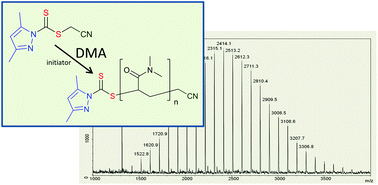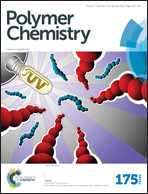Dithiocarbamate RAFT agents with broad applicability – the 3,5-dimethyl-1H-pyrazole-1-carbodithioates†
Abstract
3,5-Dimethyl-1H-pyrazole-1-carbodithioates are shown to be extremely versatile dithiocarbamate RAFT agents with wide-spread applicability. The cyanomethyl and benzyl dithiocarbamates offer very low dispersities (Đ < 1.1) for polymers based on more activated monomers [MAMs: methyl acrylate (MA), N,N-dimethylacrylamide (DMA) and styrene (St)] and Đ < 1.3 in polymerization of vinyl acetate (VAc), a less activated monomer (LAM). The tertiary, 2-cyano-2-butyl dithiocarbamate, provides molar mass control and Đ < 1.5 in methyl methacrylate (MMA) polymerization. Lower dispersities can be obtained for MMA copolymers. End group fidelity was proved with the synthesis of block copolymers, poly(DMA)-block-poly(MA). With the ability to control polymerization of both MAMs and LAMs, the RAFT agents were also shown to be suitable for the synthesis of a poly(MAM)-block-poly(LAM), specifically poly(DMA)-block-poly(VAc). The RAFT agents are an appropriate replacement for trithiocarbonate RAFT agents in most circumstances and have the distinct advantage that the RAFT agents have low odour and the derived polymers do not develop odour on storage (i.e., no low molar mass thiols are generated).


 Please wait while we load your content...
Please wait while we load your content...